
April 7, 2025: Commended cutoff at 210.
The Commended Student cutoff for the class of 2026 is confirmed at a Selection Index of 210. This was the exact level Compass projected in November based on PSAT results. This means that changes to our estimated ranges for Semifinalist cutoffs are minimal. The extreme edges — upper and lower — of our estimated ranges are a bit less probable, but the “Most Likely” scores are unchanged. The fact that Compass’s Commended cutoff estimate was correct, however, does not mean that the Semifinalist projections will prove just as accurate — there is always variability at the state level. Juniors scoring at or above 210 on the PSAT/NMSQT will be Commended Students or Semifinalists, but announcements are not made until September. Semifinalist cutoffs will not be revealed until late August or early September.
November 13: Updated with final wave of PSAT scores.
College Board released scores in three waves depending on when students took the PSAT. We have now received scores summaries for all three waves. It is possible that some late scores will still dribble in, but we are not expecting any changes. The results point to a strong upward trend in cutoffs for the class of 2026. You are welcome to jump to the table of estimates below, but we encourage students and families to read more about how we came to those estimates. For more information on the National Merit Program, in general, you may want to read Compass’s National Merit Scholarship Program Explained. If you want to browse almost two decades’ worth of cutoffs, you can find them in Compass’s National Merit Historical Cutoffs.
What is a Semifinalist Cutoff?
Each year almost 17,000 juniors are named Semifinalists in the National Merit Scholarship Program and continue on in the hopes of being one of the 15,000 Finalists and, eventually, one of the 7,500 scholarship recipients. The score needed to qualify as a Semifinalist varies by state and is known as the “cutoff.” Every student scoring at or above the Semifinalist cutoff qualifies. The cutoff is not based on a student’s overall PSAT score but on the Selection Index. The Selection Index is listed on a student’s PSAT score report. It can be calculated by doubling the ERW score, adding the Math score, and then dividing the sum by 10. For example, a 720 ERW / 730 M would have a Selection Index of (720 x 2 + 730)/10 = 217. For the class of 2025, cutoffs ranged from 208 to 223.
What is a Commended Student Cutoff?
If you performed well on the PSAT but do not qualify as a Semifinalist, you have the opportunity to be named as a Commended Student. Unlike the Semifinalist cutoffs, the Commended cutoff is set nationally. For last year’s class it was 208. Approximately 36,000 students are named Commended Students each year.
Why does Compass believe that we are likely to see cutoffs, as a whole, go up?
College Board releases very little data about score distribution. The number of top scorers is the most critical piece of information that we get this early in the process. While we do not know the number of students scoring at a particular Selection Index, we do know the number of students scoring in the 1400-1520 range, which roughly correlates to Selection Indexes of 210-228. The class of 2026 ranks 4th in the ten years since the PSAT scoring was overhauled, and this year sees the highest ever percentage of top scores. The number of Semifinalists and Commended students are capped, so cutoffs are likely to rise. But not all cutoffs. The numbers we have seen are at the national level and there is always churn at the state level. What we believe, however, is that more cutoffs will go up than down.
There is a good correlation between the 1400-1520 band of students and the Commended Student score. We believe that the Commended cutoff will come in between 209 and 211, with a 210 being most likely. Based on our historical archive of Semifinalist and Commended cutoffs, we believe that the average Semifinalist cutoff will go up this year.
Will I find out my status right away?
No. In fact, students don’t learn of Semifinalist status until September of senior year. Compass tracks data on current year performance and historical records to provides estimates and updates between PSAT score release and the Semifinalist announcements. Last year — the first year of the digital PSAT — saw a noticeable uptick in scores. Only one state — South Dakota — saw a lower cutoff versus the previous year’s. Was this a onetime quirk? Based on early results for the class of 2026, we do not believe that it was. The upward trend — whether due to the new test format, recovery from COVID-era learning loss, or other factors — appears to be continuing.
One mistake students make is thinking that the cutoff for one year will be the same in the next year. Cutoffs change every year, sometimes by as much as 5 or 6 points (granted, that’s unusual). Compass emphasizes an Estimated Range, which is likely to include the ultimate cutoff. Within that range, we do provide our Most Likely. That score represents our best estimate based on the known factors, but there are many unknown factors. Most of our PSAT performance data are for national results. So we can usually peg the Commended cutoff within a point or two. States, however, can move in different directions. More Alaskan students may test this year. Some strong Rhode Island prep schools may have decided to stop offering the PSAT. A COVID outbreak in Montana could mean more students using Alternate Entry and entering the competition using SAT scores. Below is a table that shows how many states in each of the last 17 years saw increases, decreases, or no change. There has never been a year where even half of all state cutoffs remain unchanged.
The chart below divides the 50 states into those that saw increases (blue), those that remained unchanged (gray), and those that saw declines (red).
Historically, a change in cutoff is more likely than not. Over the decade from 2015 – 2024, Semifinalist cutoffs remained unchanged only about one-third of the time.
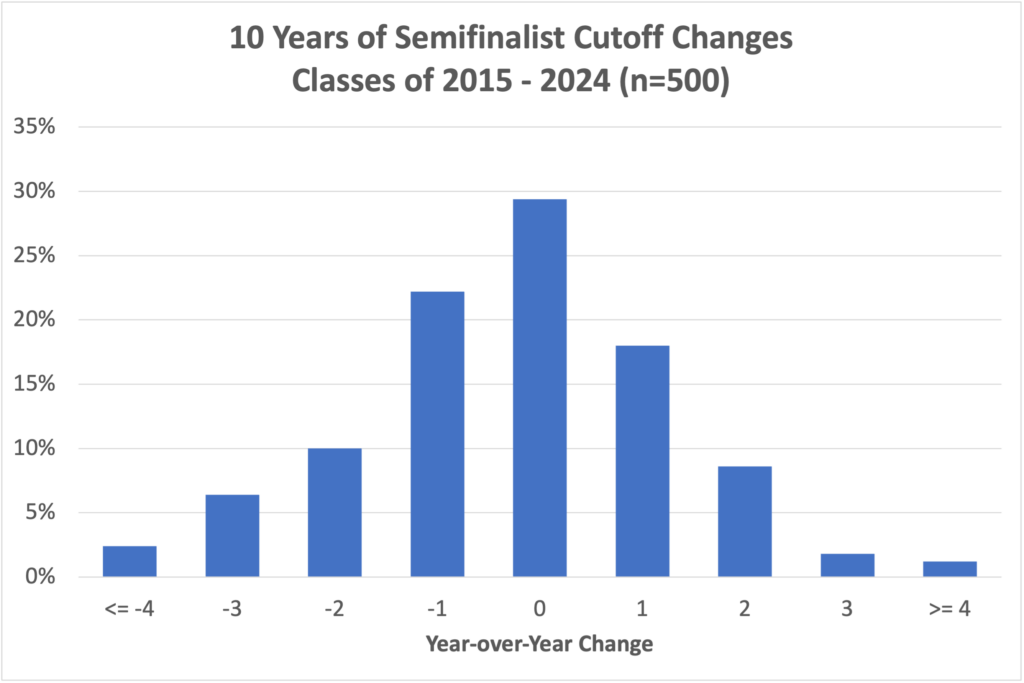
We believe that a table of results from this class will skew to the right.
Small states have more volatile cutoffs than large states, but there can be surprises across the board. The PSAT had a significant overhaul in scoring in 2017. If we look at the minimum and maximum cutoffs during the 9-year period from then until the class of 2025, we see that the 13 largest states (about 100,000 or more high school graduates) average a 2.8-point differential. New Jersey has a 1-point differential, since its lowest cutoff is 222 and highest is 223. The smallest states (fewer than 30,000 graduates) have a 6.2 point differential. Alaska has been as low as 208 and as high as 217! The medium-sized states average a 5-point difference between minimum and maximum.
Here are Compass’s current estimates for Semifinalist cutoffs for the class of 2026:
State | Class of 2026 Estimated Range | Class of 2026 Most Likely | Class of 2025 (Actual) | Class of 2024 (Actual) | Class of 2023 (Actual) | # of 2025 Semifinalists |
|---|---|---|---|---|---|---|
| Alabama | 210 - 216 | 214 | 212 | 210 | 212 | 267 |
| Alaska | 210 - 216 | 214 | 214 | 209 | 210 | 36 |
| Arizona | 215 - 220 | 218 | 217 | 216 | 214 | 401 |
| Arkansas | 210 - 215 | 213 | 213 | 210 | 210 | 134 |
| California | 220 - 223 | 222 | 221 | 221 | 220 | 2103 |
| Colorado | 216 - 221 | 218 | 218 | 216 | 217 | 272 |
| Connecticut | 220 - 222 | 221 | 221 | 221 | 221 | 177 |
| Delaware | 218 - 221 | 220 | 219 | 219 | 218 | 43 |
| District of Columbia | 222 - 224 | 223 | 223 | 223 | 223 | 47 |
| Florida | 216 - 220 | 218 | 217 | 216 | 216 | 972 |
| Georgia | 217 - 221 | 219 | 218 | 217 | 218 | 624 |
| Hawaii | 215 - 220 | 218 | 217 | 217 | 215 | 74 |
| Idaho | 212 - 217 | 214 | 213 | 211 | 215 | 102 |
| Illinois | 218 - 222 | 220 | 220 | 219 | 219 | 738 |
| Indiana | 214 - 219 | 217 | 217 | 216 | 214 | 304 |
| Iowa | 211 - 217 | 214 | 212 | 210 | 212 | 156 |
| Kansas | 213 - 219 | 216 | 215 | 214 | 214 | 142 |
| Kentucky | 211 - 217 | 214 | 213 | 211 | 212 | 202 |
| Louisiana | 212 - 217 | 215 | 214 | 214 | 213 | 238 |
| Maine | 212 - 217 | 215 | 214 | 213 | 215 | 53 |
| Maryland | 221 - 224 | 222 | 222 | 221 | 222 | 296 |
| Massachusetts | 221 - 224 | 223 | 223 | 222 | 220 | 294 |
| Michigan | 216 - 220 | 218 | 218 | 217 | 218 | 511 |
| Minnesota | 216 - 220 | 218 | 217 | 216 | 216 | 288 |
| Mississippi | 210 - 215 | 213 | 212 | 209 | 210 | 155 |
| Missouri | 214 - 218 | 216 | 215 | 214 | 213 | 276 |
| Montana | 208 - 213 | 210 | 209 | 209 | 207 | 45 |
| Nebraska | 210 - 216 | 213 | 211 | 210 | 212 | 118 |
| Nevada | 211 - 218 | 215 | 214 | 211 | 210 | 162 |
| New Hampshire | 214 - 219 | 217 | 217 | 215 | 213 | 55 |
| New Jersey | 222 - 224 | 223 | 223 | 223 | 223 | 474 |
| New Mexico | 209 - 215 | 212 | 211 | 207 | 208 | 94 |
| New York | 219 - 221 | 220 | 220 | 220 | 219 | 1089 |
| North Carolina | 216 - 220 | 218 | 218 | 217 | 217 | 518 |
| North Dakota | 209 - 213 | 210 | 210 | 207 | 209 | 28 |
| Ohio | 215 - 219 | 217 | 217 | 216 | 216 | 582 |
| Oklahoma | 209 - 215 | 212 | 211 | 208 | 211 | 214 |
| Oregon | 215 - 220 | 217 | 216 | 216 | 216 | 205 |
| Pennsylvania | 217 - 221 | 219 | 219 | 219 | 218 | 583 |
| Rhode Island | 213 - 220 | 217 | 217 | 215 | 216 | 50 |
| South Carolina | 210 - 217 | 215 | 214 | 209 | 213 | 234 |
| South Dakota | 209 - 214 | 211 | 208 | 209 | 212 | 41 |
| Tennessee | 215 - 219 | 218 | 217 | 217 | 215 | 319 |
| Texas | 218 - 221 | 220 | 219 | 219 | 219 | 1714 |
| Utah | 210 - 216 | 213 | 211 | 209 | 211 | 195 |
| Vermont | 211 - 217 | 215 | 215 | 212 | 213 | 33 |
| Virginia | 220 - 223 | 222 | 222 | 219 | 221 | 394 |
| Washington | 220 - 223 | 221 | 222 | 220 | 220 | 358 |
| West Virginia | 209 - 212 | 210 | 209 | 207 | 207 | 66 |
| Wisconsin | 213 - 217 | 215 | 214 | 213 | 213 | 289 |
| Wyoming | 209 - 213 | 211 | 209 | 207 | 207 | 24 |
| U.S. Territories | 209 - 211 | 210 | 208 | 207 | 207 | 45 |
| Studying Abroad | 222 - 224 | 223 | 223 | 223 | 223 | 112 |
| Commended | 209 - 211 | 210 | 208 | 207 | 207 |
If you’d like to see even more historical data, you can find cutoffs going back to 2008 in Compass’s National Merit Historical Cutoffs.
Why does each state have its own Semifinalist cutoff if the program is NATIONAL Merit?
This is always a hot button question. NMSC allocates the approximately 17,000 Semifinalists among states based on the annual number of high school graduates. That way, students across the nation are represented. It also means that there are very different qualifying standards from state to state. A Massachusetts student with a 220 might miss out on being a Semifinalist. If she lived 10 miles away in New Hampshire, she would qualify.
NMSC sets a target number of Semifinalists for a state. For example, California sees about 2,000 Semifinalists every year, Michigan 500, and Wyoming 25. In each state, NMSC determines the Selection Index that comes closest to matching its target number of Semifinalists. If 1,900 California students score 222 and higher and 2,050 score 221 or higher, then the Semifinalist cutoff would be 221 (this assumes that the target is exactly 2,000). Because score levels can get crowded, it is easy for cutoffs to move up or down a point even when there is minimal change in testing behavior or performance.
No Semifinalist cutoff can be lower than the national Commended level. Cutoffs for the District of Columbia and for U.S. students studying abroad are set at the highest state cutoff (typically New Jersey). The cutoff for students in U.S. territories and possessions falls at the Commended level each year. Boarding schools are grouped by region. The cutoff for a given region is the highest state cutoff within the region.
Why does the number of top scorers vary from year to year?
While there are changes in the number of students taking the PSAT/NMSQT, there can also be small flaws in test scaling that play a role. Prior to the digital PSAT, a single test form was seen by a large percentage of test takers. Something amiss with that single form could impact selection cutoffs across the country. The digital PSAT is constructed differently. Students receive unique form codes drawn from a large pool of problems. Scaled scores are generated based on the characteristics of those problems. In theory, this should make scores more stable. College Board’s early studies have found an extremely high correlation between the paper-and-pencil test and digital test. Still, even with its adaptive nature, the uncertainty remains as to whether the much shorter test can reliably score students at the 700-760 end of the scale.
What if I missed the PSAT because of illness or other legitimate reason?
You may still be able to enter the scholarship program by applying for Alternate Entry using an SAT score. Find information about last year’s process in Compass’s explanation of National Merit alternate entry.
When are National Merit Semifinalists announced?
The Commended cutoff becomes unofficially known by the end of April. The lists of Semifinalists are not distributed to high schools until the end of August. NMSC sets a press embargo on Semifinalist announcement until mid-September, but schools are allowed to notify students before that date. NMSC does not send Commended Student letters to high schools until mid-September. Compass will keep students updated on developments as those dates approach.
Do state and national percentiles indicate whether I will be a National Merit Semifinalist?
No! Approximately 1% of test takers qualify as Semifinalists each year, so it is tempting to view a 99th percentile score as indicating a high enough score — especially now that College Board provides students with percentiles by state. There are any number of flaws that rule out using percentiles as a quick way of determining National Merit status.
- Percentiles are based on section scores or total score, not Selection Index
- Percentiles are rounded. There is a large difference, from a National Merit perspective, between the top 0.51% and the top 1.49%
- Percentiles reveal the percentage of students at or below a certain score, but the “at” part is important when NMSC is determining cutoffs.
- The number of Semifinalists is based on the number of high school graduates in a state, not the number of PSAT takers. Percentiles are based on PSAT takers. States have widely varying participation rates.
- Most definitive of all: Percentiles do not reflect the current year’s scores! They are based on the prior 3 years’ performance. They are set even before the test is given. And if you are going to use prior history, why not use the completely accurate record of prior National Merit cutoffs rather than the highly suspect percentiles?
Entry requirements for National Merit versus qualifying for National Merit.
Your PSAT/NMSQT score report tells you whether you meet the eligibility requirements for the NMSP. In general, juniors taking the October PSAT are eligible. If you have an asterisk next to your Selection Index, it means that your answers to the entrance questions have made you ineligible. Your answers are conveniently noted on your score report. If you think there is an error, you will also find instructions on how to contact NMSC. Meeting the eligibility requirements simply means that your score will be considered. Approximately 1.4 million students enter the competition each year. Only about 53,000 students will be named as Commended Students, Semifinalists, Finalists, or Scholars. See National Merit Explained for more information.

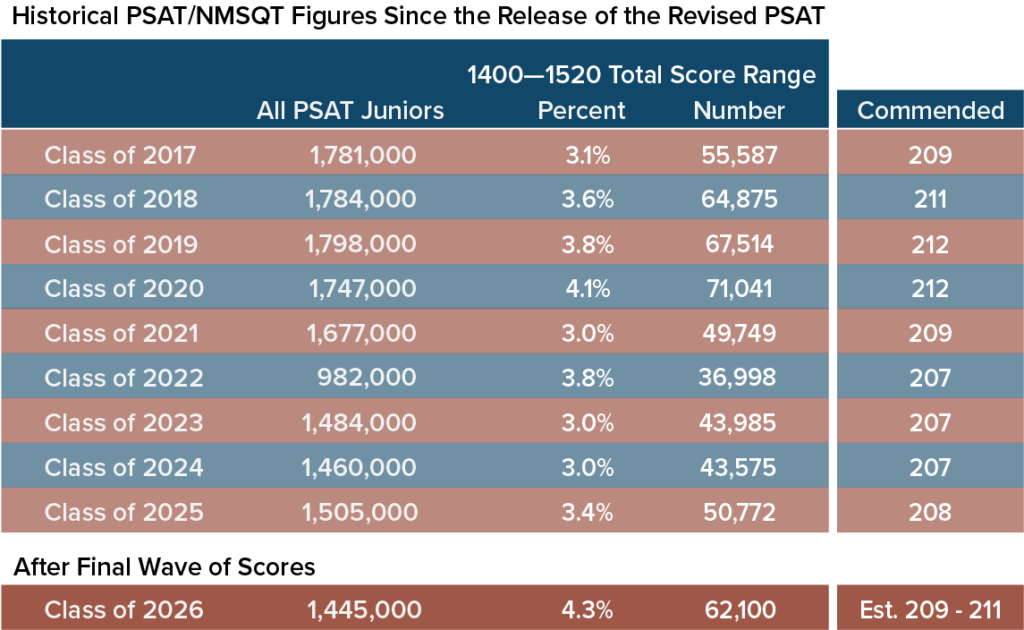
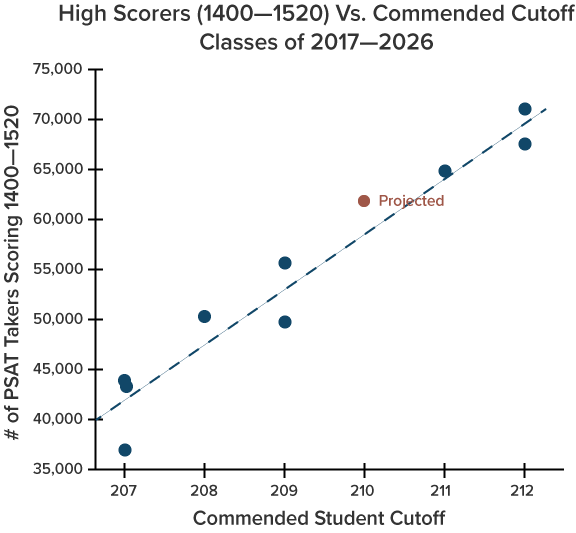
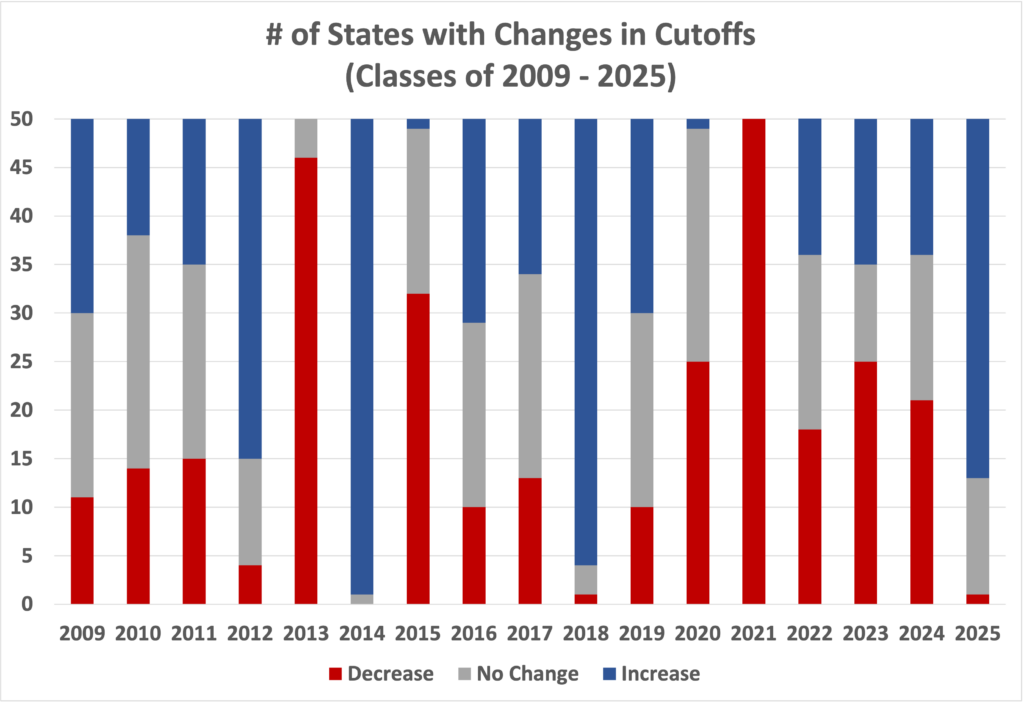
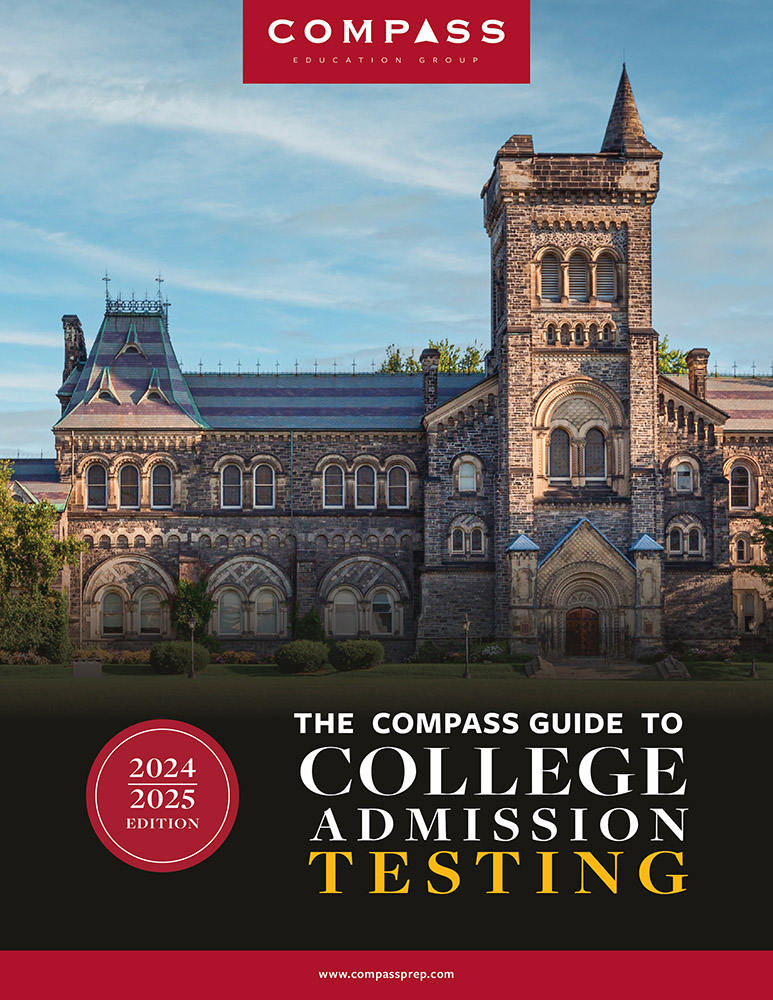
Hi,
I wanted to see what my chances are of becoming a semifinalist in the state of Oklahoma with a score of 212. The likely score was exactly 212 and last year it was 211.
Raj,
I’d say maybe 60/40 in your favor. Oklahoma has seen some large changes in the past, so we can’t ignore the possibility that it moves above 212.
Hi.
I’m a member of the class of 2026 in New York State.
I scored 218 in the fall, so I likely will not be a semifinalist.
I was wondering what it means if I am neither a semifinalist nor am I commended. Do I have anything to show for it?
-Oliver
Oliver,
Although 218 will likely fall short of the Semifinalist cutoff in NY, it will be well above the Commended level of 210. You will receive official confirmation in mid-September.
Hello, I scored a 224 index in New Jersey, but I saw that this year 4% of students scored between a 1415 and 1520 which is a big increase compared from last year so do you think there’s any chance that New Jersey’s index is going to move up to 225?
Jack,
Congratulations! Your 224 is going to be enough to qualify as a Semifinalist. Yes, it seems like we are going to have higher cutoffs overall. But we’ve had class years with even more high scores, and New Jersey has never topped 223. It’s not a straight line. The air becomes very thin above 223. Will we ever see a 224 cutoff (I throw out Maryland’s COVID-lockdown number)? Maybe. Will we ever see a 225 cutoff? No.